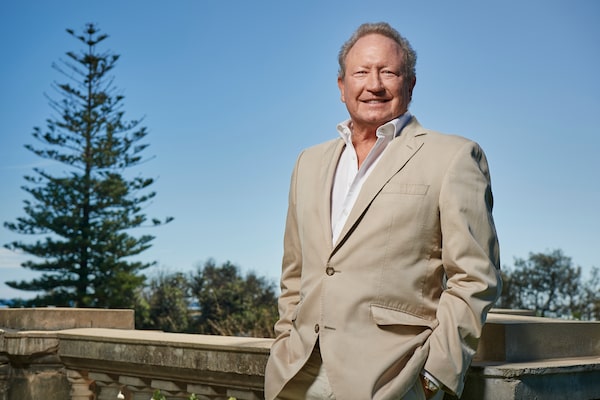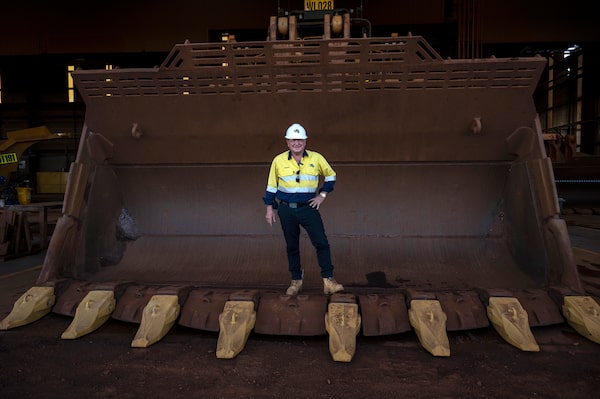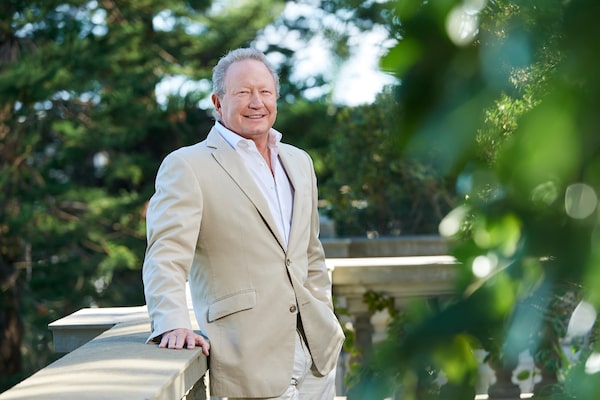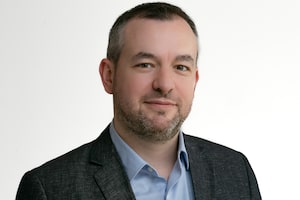
Fortescue Future Industries Chairman Andrew Forrest at the company's office in Perth, Australia, on Aug 12.Frances Andrijich/The Globe and Mail
Australia’s second-richest person does not wait long to begin proselytizing, after taking his seat for an interview on a New York patio.
“We’re commercializing the beginning of the end of global warming,” he proclaims.
Andrew Forrest, mining baron turned green prophet, is talking about his push to become the world’s dominant producer of emissions-free hydrogen – a nascent energy source that he believes will unlock a revolutionary shift away from fossil fuels to power heavy industry planet-wide.
Sipping warm tea on a hot summer day, to the slight confusion of staff at the Peruvian restaurant where he’s set up camp with a half-dozen staffers before speaking at a nearby conference, he’s soon explaining where Canada fits in.
The country has the potential, he says, to produce enough hydrogen domestically to fuel its own industry – “all the processing plants, fertilizer, steel, artificial methanol, artificial aviation fuel, you name it.” But that would just be a “fantastic way stop.”
“Canada should be an exporter of power,” he says. “That’s our dream for Canada.”

Range of hydrogen demand by global temperature rise scenario
Megatonnes of hydrogen
< 1.8ºC
1.8–2.3ºC
> 2.3ºC
Higher end
Lower end
600
500
400
300
200
100
0
2010
2015
2020
2025
2030
2035
2040
2045
2050
SOURCE: PwC

Range of hydrogen demand by global
temperature rise scenario
Megatonnes of hydrogen
Below 1.8ºC
1.8 to 2.3ºC
Over 2.3ºC
Higher end
Lower end
600
500
400
300
200
100
0
2010
2015
2020
2025
2030
2035
2040
2045
2050
SOURCE: PwC

Range of hydrogen demand by global temperature rise scenario
Megatonnes of hydrogen
600
Below 1.8ºC
1.8 to 2.3ºC
Over 2.3ºC
Higher end
500
Lower end
400
300
200
100
0
2010
2015
2020
2025
2030
2035
2040
2045
2050
SOURCE: PwC
It’s a compelling case charismatically delivered, by the man who became a household name in his home country – where he’s widely known by his childhood nickname Twiggy – after defying naysayers to build an iron ore empire through Fortescue Metals Group Ltd., which he founded two decades ago.
And at a moment when fallout from Russia’s invasion of Ukraine is causing energy strategies and relationships to be rewritten, Mr. Forrest has a receptive audience for his pitch – in principle, at least – in Canada and among its trade partners.
Hydrogen is far from universally embraced as a fuel of the future. Past waves of excitement around it have fizzled out, and there are analysts who believe it’s being overhyped again. They point to the extremely large amounts of energy and associated financial costs required to make it in a sustainable way, as well as challenges transporting it safely and efficiently across large distances.
That isn’t stopping some countries, led by Germany, from turning to hydrogen as a primary long-term replacement for Russian natural gas and other fossil fuels. And they, too, see Canada as an appealing source, if it leverages its relative excess of hydroelectricity and other renewable power generating capacity – particularly the potential for wind-powered generation in the Atlantic provinces – for hydrogen production.
German Chancellor Olaf Scholz receives Prime Minister Justin Trudeau in Berlin.MICHELE TANTUSSI/Reuters
That opportunity will be in the spotlight this week during a visit to Canada by German Chancellor Olaf Scholz, when he and Prime Minister Justin Trudeau are expected to ink an agreement to develop hydrogen trade between the two countries.
It’s a major potential component of Canada’s aim to become one of the world’s top three hydrogen-producing countries – a goal identified in a hydrogen strategy, released in late 2020 by Mr. Trudeau’s government, that envisioned the industry creating 350,000 domestic jobs.
How much of a role Mr. Forrest could and should play in trying to make the Canadian hydrogen dream a reality is an open question. In what he demands of governments, private-sector partners and the public, he epitomizes some of the challenges of figuring out how to place bets – and who to bet on – in a decarbonizing world.
He is the sort of big fish governments love to land as they try to make a splash in a new industry – at once offering the potential to send a positive signal to other investors, but also the danger of overpaying for fear of letting others win out. That’s because the pitch that Mr. Forrest is making to Canada – where his representatives are exploring potential hydrogen production facilities from Prince George to Newfoundland and Labrador, to the Northwest Territories – is one he’s also making lots of other places.
Fortescue Future Industries, the new clean-energy wing of his company, now has offices in 36 countries, by his count. They’re all developing project proposals, supposed to add up to 15 million tonnes of hydrogen production by 2030 – enough to meet twin goals of transforming Fortescue’s heavy-polluting operations and becoming a leading supplier to other buyers seeking to do likewise.
Not all those projects in all those countries will go ahead. Mr. Forrest appears to have established a competition between his people on the ground in each of them to prove their proposals will best suit the company’s bottom line.
The implicit message to governments is that if they want in on the action – trade opportunities, help keeping existing industry competitive, growth for other companies along the hydrogen supply chain – they need to compete for Fortescue’s investment, too.
The team of Canadian lobbyists he’s deployed, in Ottawa and several provincial capitals, is more specific in requesting subsidies, expedited regulatory processes, supportive infrastructure and a general rollout of the red carpet.
They’re not alone on that front, with other companies also seeking government support for proposed hydrogen projects. But Fortescue has the most expansive plans, and it’s developed a reputation for coming in hot, exerting a lot of pressure on the governments it’s lobbying. Mr. Trudeau’s Liberals have some cause to be amenable. That strategy paper they released nearly two years ago acknowledged this country was falling behind others in attracting hydrogen investment.
Mr. Forrest, who among his other hydrogen manoeuvres has a non-binding deal to meet much of Germany’s hydrogen demand, could be as able as anyone on the planet to get Canada into the game. (It also might not hurt that there is already an emerging relationship on other fronts: Another company he controls, Wyloo Metals Pty Ltd., is positioned to build a large nickel mine in Northern Ontario, after winning a bidding war for Noront Resources Ltd.)
But jumping headlong into his hydrogen dreams is not a no-brainer. Never mind, even, some awkwardness caused by a difference of opinion about what qualifies as a clean version of the product.
Mr. Forrest’s interest is solely in what’s called green hydrogen, in which the element is separated from water using electrolyzers powered by renewable electricity. But Ottawa’s strategy includes green and blue hydrogen – the latter involving producing the element from natural gas, and using carbon capture technology to minimize emissions.

How hydrogen is produced by polymer electrolyte membrane (PEM) electrolysis
Electrolysis is the process of using electricity to split water into hydrogen and oxygen. This reaction takes place in a unit called an electrolyzer. Like fuel cells, electrolyzers consist of an anode and a cathode separated by an electrolyte
Power supply
1
Anode
Cathode
O2
H2
H+
3
4
2
H2O
Bipolar plate
Solid electrolyte membrane
Bipolar plate
Voltage applied between electrodes
1
Water (H2O) reacts at the anode to form
oxygen (O2) and positively charged
hydrogen ions (H+)
2
The electrons flow through an external
circuit and the hydrogen ions move across
the PEM to the cathode
3
Hydrogen ions combine with electrons from
the external circuit to form hydrogen (H2)
4
SOURCE: U.S. DEPARTMENT OF ENERGY

How hydrogen is produced by polymer electrolyte membrane (PEM) electrolysis
Electrolysis is the process of using electricity to split water into hydrogen and oxygen. This reaction takes place in a unit called an electrolyzer. Like fuel cells, electrolyzers consist of an anode and a cathode separated by an electrolyte
Power supply
1
Anode
Cathode
O2
H2
H+
3
4
2
H2O
Bipolar plate
Solid electrolyte membrane
Bipolar plate
Voltage applied between electrodes
1
Water (H2O) reacts at the anode to form oxygen
(O2) and positively charged hydrogen ions (H+)
2
The electrons flow through an external circuit and the
hydrogen ions move across the PEM to the cathode
3
Hydrogen ions combine with electrons from the
external circuit to form hydrogen (H2)
4
SOURCE: U.S. DEPARTMENT OF ENERGY

How hydrogen is produced by polymer electrolyte membrane (PEM) electrolysis
Electrolysis is the process of using electricity to split water into hydrogen and oxygen. This reaction takes place in a unit called an electrolyzer. Like fuel cells, electrolyzers consist of an anode and a cathode separated by an electrolyte
Power supply
1
Anode
Cathode
Voltage applied
between electrodes
1
O2
H2
Water (H2O) reacts at the
anode to form oxygen (O2)
and positively charged
hydrogen ions (H+)
2
H+
3
4
2
The electrons flow through
an external circuit and the
hydrogen ions move across
the PEM to the cathode
3
Hydrogen ions combine
with electrons from the
external circuit to form
hydrogen (H2)
4
H2O
Solid electrolyte membrane
Bipolar plate
Bipolar plate
SOURCE: U.S. DEPARTMENT OF ENERGY
Both are mostly unproven leaps from grey hydrogen, which is produced from natural gas without carbon capture and is the environmentally unfriendly way the world’s hydrogen demand (primarily for oil refining and fertilizer manufacturing) has mostly been met to date.
Mr. Forrest lambastes blue hydrogen as greenwashing, which he calls “the biggest enemy the world has climatically right now,” because it would throw a lifeline to the fossil fuel industry, and because he’s skeptical of carbon capture.
However, ambiguity around the hydrogen market, and where Fortescue will really fit into it, is a bigger cause for pause.
Despite a lot of flashy announcements and laying of groundwork, neither Fortescue nor anyone else is actually producing green hydrogen in any significant qualities yet, so the global market has yet to take shape.
It’s not yet clear whether Fortescue or others will make the right technological investments to produce hydrogen economically at scale, whether industrial demand will prove as great as Mr. Forrest anticipates and whether theoretical arrangements (such as with Germany) that his company has made to meet that demand will work in practice.
It’s also hard to know what Canada is up against, in terms of incentives other countries offer. Even the wide range of projects Fortescue is considering within Canada has raised eyebrows among government officials, because it’s unclear which ones they should prioritize for backing.
Mr. Forrest treats questions about how it’ll all pan out as self-evident, sometimes with a theatrical flourish.
“It’s going to happen – there’s just no doubt,” Mr. Forrest says while walking from the patio toward his chauffeured car. He then raps his fist against a plywood construction fence. “It’s like, is that wood?”
His confidence, along with his track record, has admirers framing him as hydrogen’s answer to Elon Musk. Or explaining, as former Australian prime minister Malcolm Turnbull did in a phone interview, why he’s better suited to build the hydrogen industry than someone such as Bill Gates, who also wants to do so.
But Mr. Forrest can also be coy when pressed for details. And while it’s harder to get skeptics to go on the record, perhaps because nobody wants to publicly bet against him yet, there are whispered questions around this evolving industry about whether he can back up his bluster.
What is clear, from speaking with Mr. Forrest, is that he is pursuing his aspirations on his own terms and timeline.
And getting in on the ground floor means embracing some of the risk his approach to empire-building entails.

A helicopter carrying Mr. Forrest, founder of the Fortescue Metals Group, flies across the Pilbara region of Australia from his Cloudbreak mine to his Iron Bridge mine.DAVID DARE PARKER/The New York Times
The case for betting big on Mr. Forrest’s hydrogen ambitions revolves around two main factors: the scale of his company’s operations and the force of his personality.
The two are intricately tied, because the way that the 60-year-old built Fortescue – and earned a personal fortune reportedly near US$20-billion, which he’s pledged to give away to charity over the rest of his life – is part of the case for trusting him to reinvent it as a green energy company.
He’s not a rags-to-riches tale. As a child he was a young cattle raiser (known in Australia as a jackaroo) in a remote part of the Pilbara region, contributing to a rugged image he’s cultivated. But that was on a 2,400-square-kilometre homestead passed down through generations of his family, which included Western Australia’s first premier, and he attended an elite boarding school.
Nevertheless, he built his mining empire more or less from scratch. After starting as a stockbroker, then running (and being acrimoniously ousted from) a troubled mining company called Anaconda Nickel, he took over a small exploration company in 2003 and relaunched it as Fortescue Metals when his reputation was at a low point.
Fortescue was built around a series of high-risk plays. Mr. Forrest seized on Australian iron ore deposits rejected by existing mining giants; counted on new technologies to make commercially viable a lower grade of the mineral than was industry standard; and figured the value of his product, a raw material for steel, would skyrocket because of Chinese demand.
It added up to a big gamble to which he draws parallels as he tries to commercialize green hydrogen.

Mr. Forrest at Cloudbreak, Fortescue's first mine, in Mulga Downs, Western Australia.DAVID DARE PARKER/The New York Times
An autonomous vehicle drives along a road as it collects iron ore at Australia's Fortescue Metals Group mine in the Pilbara region.Melanie Burton/Reuters
Now, he’s trying to disprove naysayers who question whether hydrogen electrolysis can be achieved without heavy energy loss that makes it inefficient and negates environmental benefit. Or whether transporting supplies of hydrogen (which is highly combustible and thus poses safety concerns) across large distances can really be made feasible enough to create a reliable global network, including by storing the element in ammonia, as Fortescue and other companies intend.
(Some investors, in Canada in particular, also have long memories of the hype around Vancouver’s Ballard Power Systems Inc. in the 1990s, and the subsequent collapse of its share price when the hydrogen fuel cell revolution it predicted in transportation failed to materialize.)
This time, Mr. Forrest is at the helm of a behemoth, which is where his scale advantage comes in.
For one thing, Fortescue can absorb more risk than some other would-be green hydrogen developers. Mr. Forrest has pledged at least 10 per cent of Fortescue Metal Group’s net profits – which topped US$10-billion last fiscal year, a company record – toward FFI. (Profits may currently be significantly lower, because of a drop in iron ore prices, but market volatility is somewhat baked into the equation.)
Scale also seems to be helping with a basic supply-and-demand dilemma: Industries and countries looking to transition away from fossil fuels have been reluctant to stake their futures on an energy source not yet widely available, and would-be suppliers have been deterred by a lack of guaranteed customers.
If all goes according to plan, Fortescue will soon start to fulfill both ends of the equation itself by becoming one of the first big consumers of the hydrogen it produces, using it in its mining and shipping operations.
E.ON headquarters in Essen, Germany.Thilo Schmuelgen/Reuters
That, in turn, has helped give Mr. Forrest credibility to strike deals with other future customers. The biggest of those is a memorandum of understanding (MOU) with the German energy company e.ON to deliver up to five million tonnes of hydrogen to Europe by 2030.
Mr. Forrest brushes off criticism that he’s making promises he hasn’t yet proven he can keep.
“Anyone who thinks you should get into production before you establish a market probably needs to go back to primary school,” he scoffs.
Some industry analysts agree, if in less combative terms. “Signing offtake agreements and establishing long-term contracts are a very positive indicator in our book, legitimizing a project and its developer,” says Bridget van Dorsten, who specializes in hydrogen for the global energy consultancy Wood Mackenzie.
Fortescue is also laying groundwork to ramp up production. That includes construction of the world’s largest electrolyzer factory, slated for 2023 completion in West Australia.
Even if the company won’t move forward in all the countries where it’s considering making hydrogen, the aim is to be operational in enough places to comfort potential customers about reliability.
“If I switch over from oil and gas, I’ve got to know that supply is going to be continuous,” Mr. Forrest says. “I’ve got to convince not only companies, but entire countries like Germany,” that “if something goes wrong in a country, or a ship sinks, or whatever,” they won’t be left in the lurch.

Former Australian prime minister Malcolm Turnbull.MARK GRAHAM/AFP/Getty Images
Mr. Forrest’s ability to speak as someone who made his name in resource development is why Mr. Turnbull made the favourable comparison to Mr. Gates, who intends to back green hydrogen through his Breakthrough Energy Investments fund.
“I think the difference between Andrew and some equally well-intentioned hyper-rich people is that he hasn’t made his fortune in software,” said the former Australian prime minister, who heads the Green Hydrogen Organization (GH2), a new international body Mr. Forrest has been instrumental in setting up.
“Fortescue has by necessity an engineering culture. These are people that understand the business of building physical things. So I think that gives them some unique qualifications and the ability to put the pieces together at a large scale.” Mr. Turnbull then hedged, just a little.
“Of course, his ambition is enormous – whether he can realize it all, who knows,” he said. “If Andrew doesn’t succeed in achieving everything he set out to do, it won’t be through lack of trying.”
But how Mr. Forrest is going about that effort, though – how he intends to bring all the pieces together – is where things remain a bit fuzzy.

'No one really knew, up until this point, what green was,' Mr. Forrest says. 'Now everyone knows, we can finance, we can fund derivatives off it. It’s now a thing.'FRANCES ANDRIJICH/The Globe and Mail
With a gregarious manner and a gleam in his eye, Mr. Forrest presents himself as an open book.
Early in the interview, he repeatedly offers encouragement to ask tough questions. Later, out of time before heading to his speaking engagement, he invites his interviewer to ride over with him, to keep chatting.
On some subjects, he indeed proves plain-spoken, for better or worse.
That’s the case with how he approaches Indigenous relations. FFI has opened on a positive note in Canada, reaching MOUs with three First Nations – the Lheidli T’enneh in British Columbia, the Homeguard Cree in Manitoba and the Innu in Labrador – before seriously considering hydrogen projects on their lands.
Malcolm Macpherson, who chairs the Indigenous Practice Group for the law firm Clark Wilson LLP and represents the Lheidli T’enneh, said they’ve been encouraged by FFI’s “early engagement and collaborative approach.”
But in Australia, Mr. Forrest has alternately been praised for prioritizing Indigenous economic opportunity and accused of being patronizing. Fortescue has been on the losing end of a protracted legal battle with the Yindjibarndi People of Western Australia after failing to reach an agreement before building an iron ore mine on their traditional lands.
Asked about that mixed reputation, Mr. Forrest says he grew up alongside Indigenous people. “I spoke the language, got taught how to hunt and trap and do corroboree. So I really know them. It made doing agreements really easy.” Then he gets more defensive.
“What we insist on is a very real relationship, and 19 out of 20 Indigenous groups love that,” he says. “They’re not necessarily used to it, but they love it. We do mining joint ventures, we employ them, we do all sorts of things. What we’re not good at, and will never be, is just handing out huge amounts of cash with no responsibility attached.”
“So pea-brained critics just pick up that and say, ‘He’s having an argument with one group,’” he says. “Yeah, that’s because they are a despotic, misogynist group who just wants heaps and heaps of cash. We’re just not going to go along with that.”
It’s difficult to know what to make of that explanation absent intricate knowledge of dealings on the other side of the world, though the Yindjibarndi have generally been portrayed favourably by Australian media. But it’s exceedingly rare these days to hear Canadian business leaders speak publicly in such terms, and it’s fair to wonder how his mentality would translate here if relations got contentious.
Mr. Forrest can be a bit dismissive about other concerns raised about his ambitions, as well.
Some environmentalists have warned that hydrogen production could use up so much available renewable electricity that it would limit supply for other forms of energy transition. That’s not an issue with some Fortescue plans, including potential ones in Atlantic Canada, which would involve building its own wind or solar power generation. But it could be elsewhere, including B.C., where FFI is interested in tapping into existing hydroelectricity.
“Anybody who looks at the production of renewable hydrogen, it’s obvious that if you don’t use additional renewable electricity, it’s going to incentivize the use of fossil fuel electricity,” said Dominic Eagleton, who specializes in hydrogen for Global Witness, a London-based NGO.
“Honestly, that would never happen,” Mr. Forrest replies. He says utilities will sell clean electricity to meet standard demand, because that’s “bog easy,” and only get into more complex arrangements for hydrogen production if they have excess supply. That’s a reasonable premise, but it displays a lot of faith in utilities to plan for future demand increases from other consumers before locking into contracts with his company.
Where he gets cagier, though, is around specifics of what he’s seeking from governments.
“Have we?” he replies when asked about FFI hiring a team of lobbyists (from the firm Global Public Affairs) to represent its interests in Canada.
He initially suggests they’re likely engaging with governments on regulatory issues, as opposed to subsidies.
In fact, his company has applied to the federal Clean Fuels Fund and the Net Zero Accelerator – programs that subsidize investments in low-emissions products. “We probably do,” he says when this is mentioned to him.
He insists he doesn’t worry too much about such things, because he counts on his staff to be steered by Fortescue’s 10 values. He’s referring to a corporate document that lays out foundational principles such as “humility,” “frugality,” “courage and determination,” “safety” and “stretch targets.”
“I don’t care when a decision is made [in Canada], because if they stick to those 10 values, I know roughly what they’re going to do anyway and it’s going to be a good decision,” he says. “Or if it’s a long shot, and it’s going to fail, they’ll have a plan B.”
Fortescue is indeed known for trying to drill the values into employees. But his purported remove is a bit hard to square with accounts, including from Mr. Turnbull and people who have worked for the company, that Mr. Forrest stayed closely atop operations even before he ostensibly reclaimed a more hands-on role during a recent corporate shuffle, in which he went from chairman to executive chairman.
It also adds to the difficulty in getting a true sense of how Canada fits into Fortescue’s wider plans.
It’s possible to glean from other sources that among hydrogen projects under consideration here, two of the more advanced are in Prince George and a to-be-determined location in Nova Scotia. FFI also recently announced it is submitting an environmental assessment for a possible project on Newfoundland’s west coast. And it has been in talks with Trigon Terminals, which controls a shipping facility in Prince Rupert used for coal exports, about exporting hydrogen (via ammonia) to Japan.
But it’s not at all clear how close those projects are to fruition. Some Canadians who have engaged with FFI here describe the company signalling interest with a flourish, then being slow to follow up with details. The lack of urgency might justify skeptics’ questions about Mr. Forrest’s seriousness. Or it might be by design.
When Mr. Trudeau and Mr. Scholz visit Stephenville, N.L., on Wednesday to sign their agreement and showcase Atlantic Canada’s potential for green hydrogen projects (largely because of its untapped potential to produce excess wind-powered electricity), Fortescue representatives will be there.
But other companies now also proposing green hydrogen projects in that region – including World Energy GH2 (backed by Nova Scotia billionaire John Risley), EverWind Fuels and Brookfield Renewable Power – will likely be there as well. Some of them, too, already have bids in for government subsidies.
Elsewhere, plans for green hydrogen projects have started to take shape – including the world’s largest planned facility to date, by a startup called Green Hydrogen International, which is supposed to produce 2.5 million tonnes annually in Texas.
Competition is heating up, which might prompt Fortescue to accelerate locking in its own plans. But Mr. Forrest, seemingly banking on the magnitude of his planned efforts giving him more leeway, insists otherwise.
“I’m not feeling a lot of pressure, I have to admit to you,” Mr. Forrest says, about how quickly Fortescue settles on hydrogen projects and gets shovels in the ground.
That’s despite the urgency with which he talks about replacing fossil fuels, the 2030 targets he’s set and expectations he’ll start delivering to customers such as Germany much sooner.
He explains it as a matter of letting technologies continue to advance, launching into an overview of how cost curves are changing as science evolves. Electrolyzers are getting cheaper to make; renewable electricity development is increasingly efficient; new production methods are being tested and bets on them are being hedged for as long as possible.

Forecast global range of levelized cost of hydrogen production from large projects
2019 U.S. dollars per kg
Renewable hydrogen
Hydrogen from natural gas with CCS*
Hydrogen from coal with CCS*
$5.0
4.5
4.0
3.5
3.0
2.5
2.0
1.5
1.0
0.5
0
2019
2030
2050
*Carbon capture and storage.
SOURCE: BLOOMBERGNEF

Forecast global range of levelized cost of hydrogen production from large projects
2019 U.S. dollars per kg
Renewable
hydrogen
Hydrogen from
natural gas with CCS*
Hydrogen from
coal with CCS*
$5.0
4.5
4.0
3.5
3.0
2.5
2.0
1.5
1.0
0.5
0
2019
2030
2050
*Carbon capture and storage.
SOURCE: BLOOMBERGNEF

Forecast global range of levelized cost of hydrogen production from large projects
2019 U.S. dollars per kg
Renewable
hydrogen
Hydrogen from
natural gas with CCS*
Hydrogen from
coal with CCS*
$5.0
4.5
4.0
3.5
3.0
2.5
2.0
1.5
1.0
0.5
0
2019
2030
2050
*Carbon capture and storage.
SOURCE: BLOOMBERGNEF
It doesn’t just seem like an excuse for stalling. He speaks with obvious excitement about the innovation at play.
He also discusses energy transition with a zeal increasingly common among people from polluting industries who want to rewrite their climate-change legacies before it’s too late. In his case, the journey included successfully pursuing a PhD in marine science in his 50s.
But he didn’t get to where he is without being a shrewd businessman who knows how to work the angles.
The longer he waits to lock in plans, the more he drums up a battle for his affections among governments keen on the green jobs and enhanced industrial competitiveness that he promises as he jets around the world selling his vision.
And while he gets reports from his people on the ground about where direct subsidies, favourable electricity rates and other incentives stack up to allow the lowest per-unit production costs, his suitors have a less clear picture of what they’re up against.
Meanwhile, he keeps moving to shape the industry that doesn’t yet exist.
In May, GH2 – the new international hydrogen association chaired by Mr. Turnbull, and very closely tied to Fortescue – held its inaugural conference in Barcelona.
It saw the launch of a new Green Hydrogen Standard, which defines the product as being produced through electrolysis of water using renewable energy with “close to zero greenhouse gas emissions,” and lays out criteria around areas such as transparency, verification and stakeholder engagement for projects to be certified.
“No one really knew, up until this point, what green was,” Mr. Forrest says. “Now everyone knows, we can finance, we can fund derivatives off it. It’s now a thing.”
It also “strikes a dig,” he says, at fossil fuel producers trying to present their hydrogen-making efforts as equally clean.
More than that, the standard launch and the summit itself – where Mr. Forrest played a starring role, surrounded by the likes of U.S. presidential envoy John Kerry and energy ministers from governments around the world – was an obvious power play.
He has established himself as the world’s most prominent green hydrogen advocate; it remains to be seen if he will also prove its biggest seller.
As he tries to write the rules of the game, it’s up to everyone else to decide how much they want to play on his terms.
 Adam Radwanski
Adam Radwanski